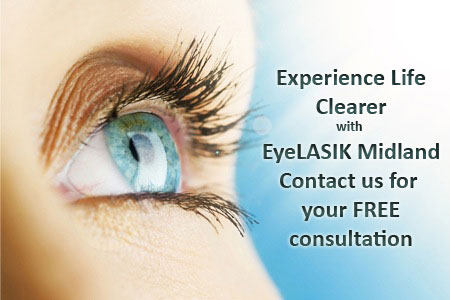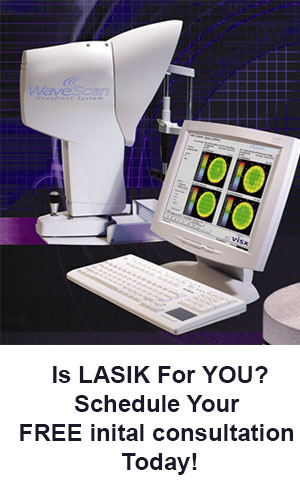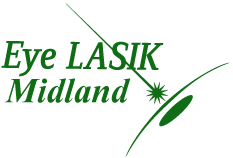
by EyeLASIK | Jul 30, 2014 | better vision, Eye LASIK, laser vision correction surgery
The first step in the LASIK procedure is the evaluation or consultation. During this appointment a trained eye doctor evaluates your results to ensure you’re a candidate for laser eye surgery. After a thorough discussion and exam, we’ll be able to determine if laser eye surgery is right for you. We’ll also recommend the best procedure based on your exam results. We perform a wavefront diagnosis using the WaveScan WaveFront system. Your eye is unique—as personal as your fingerprint or your DNA. The WaveScan WaveFront system creates a 3-D map that provides detailed information of your vision correction requirements to develop a personalized laser vision correction plan.
Want to read more about the different procedures! Check out our blog on LASIK vs. Epi-LASEK https://eyelasikmidland.com/epi-lasek-eye-surgery/
Please remember, it will be best to discontinue wearing your contact lenses several days before your evaluation appointment. Contact lenses distort the shape of your cornea, and we will want your cornea to have returned to it’s natural shape by the time of your appointment.
Ordinary defects in your vision can be corrected using eye glasses, contact lenses, and traditional LASIK surgery. Normal myopia, hyperopia, and astigmatism can be corrected using these traditional methods. However, there are irregularities of the eye that can only be spotted and treated with the Wavefront LASIK technology. The Wavefront LASIK will create an individualized laser correction program for the surface of your eye. This will be guided by a detailed analysis of the errors in your vision as seen in the way light travels through your eye.
Why does Eye LASIK Midland choose to use the Wavefront LASIK?
At Eye LASIK Midland we feel there are advantages to the Wavefront LASIK in terms of quality of your vision.
- There is a greater chance that you will achieve a twenty-twenty vision
- There is a greater chance that you will get better vision than twenty-twenty
- There is a lower chance of losing the optimal correction for your vision
- There is a lower chance of losing the quality in your vision
- There is a lower chance of losing sensitivity in terms of contrast
- There is a lower chance of getting glares
- It is unlikely that you will have problems seeing at night
There may be a chance to correct previous refractive surgeries and make seeing better with the custom LASIK refractive surgery.
Ready to make your FREE consultation with Eye LASIK Midland? Click HERE or on the image below.


by EyeLASIK | Jul 23, 2014 | better vision, Eye LASIK, laser vision correction surgery

Most people know the best ways to protect your body from harmful UV rays, but you may be forgetting about your eyes. Turns out your shades are more than a fashion statement. Sunglasses could help you avoid problems as varied as sunburn, cataracts and skin cancer.
Let’s look at a list of how specific areas of your eye are effected by the sun.
White of the eye
Sun damage can cause a condition called pinguecula, a thickening of the conjunctive, which is the clear, thin membrane that covers the white of the eye. This causes raised, yellow spots on the eye, near the cornea. While there’s no known danger to vision, it can get irritated and inflamed. The conjunctiva also thicken and grow over the cornea, creating a condition called pterygium (also known as surfer’s eye), which might obscure vision.
Iris
Research has suggested that blue-eyed people are more susceptible to macular degeneration, according to Brown. While at this point we don’t know the exact reason, it is recommended even more strongly that people with light eyes wear sunglasses.
Retina
The retina is a light-sensitive layer of tissue that lines the back of the eye. The macula is the part of the retina where we have straight ahead and detailed vision. That macula can start to deteriorate, causing a condition called macular degeneration, leading to blurred vision or a blind spot. Some information suggests there could be an association between UV light and macular degenation.
Lens
Behind the iris of the eye is a crystalline lens that helps to focus light onto the retina. That lens fan develop a cloudiness, whick is known as a cataract. UV light has been implicated in the development of some types of cataracts. The more you wear sunglasses and a hat, the longer you can put it off.
Cornea
Here’s a common summertime scenario: People go the shore for the day, and as they’re driving home their eyes feel kind of gritty, like maybe there’s sand in them. By 10 p.m. they’re in agony and by 11 they’ve landed in the ER for a sunburned cornea, which is a giant scratch on the cornea. While it doesn’t cause long term damage, it can cause tremendous pain and even temporary blindness.
Skin around the eyes
The skin around the eyes and, in particular, the eyelids are made up of a very thin tissue. Over time, repeated UV exposure (not to mention constant squinting) can lead to wrinkles and age spots, as well as small skin cancers around the eye.
With laser vision correction surgery you can ditch those glasses & contacts for a great pair of effective sunglasses. Schedule your FREE evaluation with Eye LASIK Midland today! Click HERE or by clicking in the image below.

by EyeLASIK | Jul 9, 2014 | better vision, Eye LASIK, laser vision correction surgery
The freedom from glasses and contacts that Lasik eye surgery offers is completely life-changing. Add in the fact that Lasik eye surgery is now one of the safest procedures you can have to correct your vision, and it no wonder millions of people have chosen to have Lasik eye surgery.
Although Lasik surgery is a simple procedure, there is still a recovery period. However, Lasik recovery is usually quick and free from pain, although you may have discomfort for a day or two after the procedure. However, there are things you can do to ensure that your Lasik recovery is successful.
Get Plenty of Rest During Recovery
After your procedure, go home and take a nap. Let your eyes rest. Although, Lasik is a safe and simple procedure, your eyes still need time to recover. The best way to give them a head start is to keep them closed. Most patients do feel some irritation once the topical anesthetic wears off, and keeping your eyes closed is a great way to minimize this irritation.
Use Your Prescription Drops as Directed During Recovery
It’s important to use the drops prescribed by your ophthalmologist as directed during your Lasik recovery. These drops should include an antibiotic, along with a steroid and possibly an anti-inflammatory medication. These will help prevent infection and swelling, while alleviating some of the irritation you may feel shortly after the procedure. If you have any questions on how to use your drops, ask your physician before you leave the surgery center.
Don’t Rub Your Eyes During Recovery
Rubbing your eyes during your Lasik recovery period can cause complications with the flap created during the procedure, which can lead to blurry vision and possibly the need for more surgery. This is another great reason to take a nap after your procedure since you won’t feel the need to rub your eyes while you’re asleep.
Where Protective Eyewear During Recovery
You’ll be given safety glasses or goggles to wear after your procedure. For the first 24 to 48 hours during your Lasik recovery, you should wear these anytime you are outside to prevent any dirt or debris from getting into your eyes. You will also need to wear these glasses or goggles anytime you sleep for the first week after the procedure. This will help prevent you from accidentally hitting or rubbing your eyes in your sleep.
Use Artificial Tears During Recovery
In the kit you are given for your Lasik recovery, you will have drops that can be used to moisturize your eyes. Use them. These artificial tears will help alleviate discomfort during your Lasik recovery, as well as keep your corneas hydrated, which will allow them to heal quickly and properly. These drops can be used as often as needed. If you will be using them at the same time as your prescription drops, use the tears first and then wait five minutes before instilling the prescribed drops.
These five tips will help to ensure your Lasik recovery goes smoothly and help alleviate any discomfort. However, be sure to check with your surgeon to see if he or she has any other recommendations for your Lasik recovery.
Ready to see if Eye LASIK surgery is for you? Schedule your FREE evaluation with Eye LASIK Midland. Click HERE or on the image below.


by EyeLASIK | Jun 25, 2014 | better vision, Eye LASIK, laser vision correction surgery
What is the IntraLase Method?
The IntraLase Method is a 100% blade-free approach to creating your corneal flap— the thin flap of tissue that the doctor folds back in order to perform your LASIK procedure.
How does it differ from other methods of creating a corneal flap?
The only other way to create a corneal flap is by using an instrument called a microkeratome. A microkeratome is a hand-held steel blade that makes a cut as it travels across the cornea. With the IntraLase Method, a blade never touches your eye.
How does the IntraLase Method work?
Tiny pulses of laser light pass harmlessly through the outer portion of your cornea and form a uniform layer of microscopic bubbles just beneath the surface of your eye. Just prior to LASIK surgery, the doctor can lift the corneal flap by gently and easily separating the tissue where these bubbles have formed.
Besides being blade free, what other benefits are there to the IntraLase Method?
IntraLase Method virtually eliminates the most severe sight-threatening complications. While LASIK complications are rare, when they do occur they are primarily related to the use of the microkeratome. The Method is 100% blade-free, exceptionally advanced, and has been shown to improve outcomes for more patients.1 And patients report better quality of vision overall, particularly in terms of their ability to see well in low light
Is the IntraLase Method proven?
To date, the IntraLase Method has been used in hundreds of thousands of LASIK procedures around the world.
How long does it take to create a flap using the IntraLase Method?
The creation of the flap itself takes only about 15-20 seconds per eye. Including preparation time, the LASIK procedure takes about 10 minutes total.
Is it painful?
No—the doctor applies drops to numb the eye.
What’s the reaction of patients who have experienced the IntraLase Method?
In a clinical survey, the vision in the IntraLase treated eye was preferred by LASIK patients 3-to-1 over the vision in the microkeratome-treated eye.
Ready to decide if laser vision correction surgery is for you? Contact Eye LASIK Midland for a free evaluation. Click HERE or on the image below to schedule your free consultation.









